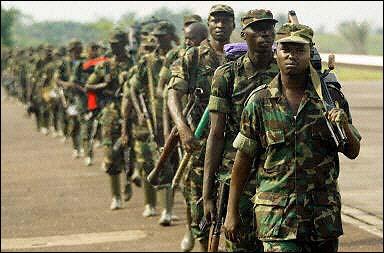 At least 150 people have been killed in the Congolese capital Kinshasa after clashes between the army and forces loyal to opposition leader Jean-Pierre Bemba. The violence started on Thursday last week and went for two days before Government troops regained control of the streets. Bemba is now currently seeking refuge in the South African embassy. Democratic Republic of Congo (DRC) President Joseph Kabila defended the role of the army saying order had to be restored “at any cost” and has demanded Bemba face justice in a Congo court.
At least 150 people have been killed in the Congolese capital Kinshasa after clashes between the army and forces loyal to opposition leader Jean-Pierre Bemba. The violence started on Thursday last week and went for two days before Government troops regained control of the streets. Bemba is now currently seeking refuge in the South African embassy. Democratic Republic of Congo (DRC) President Joseph Kabila defended the role of the army saying order had to be restored “at any cost” and has demanded Bemba face justice in a Congo court. The violence has upset the peace process which ended DR Congo's war and led to elections in 2006. In the country’s first free vote since 1960, Kabila won the presidency from Bemba in a run-off election with 58% of the vote. But Bemba rejected the result claiming the election was rigged. Violent clashes at the time claimed at least a dozen lives. Bemba was elected a senator in the new parliament and was given repeated ultimatums to disband his military force, numbering in the thousands.
Instead of disarming, Bemba’s supporters took to the streets last week and immediately sparked clashes with Kinshasa’s security forces. Shooting on Thursday morning gave way to mortar fire in the afternoon. The mortar fire set buildings ablaze and destroyed an oil refinery. Bemba himself claims he was the target of an assassination plot and said two battalions of government troops surrounded his house. Bemba escaped to the sanctuary of the South African embassy. Thousands of others were also forced to flee the capital.
Among them were 200 people (including 50 members of Bemba’s military) who took refuge across the river in Congo-Brazzaville. Although there is no bridge between the two capital cities, the refugees crossed the Congo River aboard smugglers' canoes. The soldiers were disarmed by Republic of Congo marines before being housed in transit centres and a Red Cross compound.
The Democratic Republic of Congo is still recovering from a six-year civil war, widely considered the most lethal conflict in the world since World War II. Four million died in fighting, hunger and disease. Nine nations were dragged into the carnage which mostly in eastern Congo. The east had long been a home for disaffected groups from bordering countries such as the ethnic Hutu, Interihamwe, the group most responsible for the 1994 Rwandan genocide. These groups were protected by long-term Congo dictator Mobutu Sese Seko.
In 1996, the Rwandan army invaded Congo supported by a rebel Congolese army led by Laurent Kabila (father of current president Joseph) and drove Mobutu from power. Kabila was installed as the country’s new leader. But he fell out with his allies and ordered all foreigners to leave the country. Most refused to leave. A Rwandan counter-surge was defeated by a multi-national force of Angolan, Zimbabwean, and Namibian troops. In 1999 Uganda invaded in support of rebel group called the Mouvement pour la Liberation du Congo (MLC) and established control of the north.
Congo was now divided into three parts only one controlled by Kabila, with one each for Rwanda and Uganda. In 1999 six parties (DRC, Zimbabwe, Angola, Namibia, Uganda, and Rwanda) signed the Lusaka Accord ceasefire which called for a UN peacekeeping force and the withdrawal of all foreign troops. But mutual suspicion prevented enforcement of the Accord. Kabila was assassinated in 2001 and succeeded by his son Joseph. Finally in 2002 there was progress and most of the international armies left the country. The parties ratified the Pretoria Accord in 2003 which put in place a transitional government and planned an election which eventually took place in 2006. Kabila beat Bemba in a runoff after a stalemate in the first election.
 Altogether up to 50 million people were displaced by the war. With the aid of 17,500 peacekeepers, Kinshasa has regained control of most of the country. But the east of the country remains dangerous with rebel Rwandan and Ugandan forces refusing to return to their native lands where they fear they will be targets of revenge. And while Hutu militia remain in the forests of east Congo where they prey on villages for food and money, the Rwandan army will continue to launch incursions to try to wipe them out.
Altogether up to 50 million people were displaced by the war. With the aid of 17,500 peacekeepers, Kinshasa has regained control of most of the country. But the east of the country remains dangerous with rebel Rwandan and Ugandan forces refusing to return to their native lands where they fear they will be targets of revenge. And while Hutu militia remain in the forests of east Congo where they prey on villages for food and money, the Rwandan army will continue to launch incursions to try to wipe them out.By rights Congo should be one of the richest countries in Africa. American, Canadian, European and South African mining companies have all begun to invest in the mineral-rich Katanga province in an attempt to gain access to the vast reserves of gold, diamonds, cobalt, copper and tantalum (also known as coltan, a key component of mobile phones). San Francisco based engineering firm Bechtel Inc estimates that the DRC's mineral ores alone are worth $157 billion dollars. But not everyone is benefiting from outside investment. This huge country is the size of Western Europe but has few roads and little electricity outside the major cities. The Congo remains the heart of darkness.
No comments:
Post a Comment